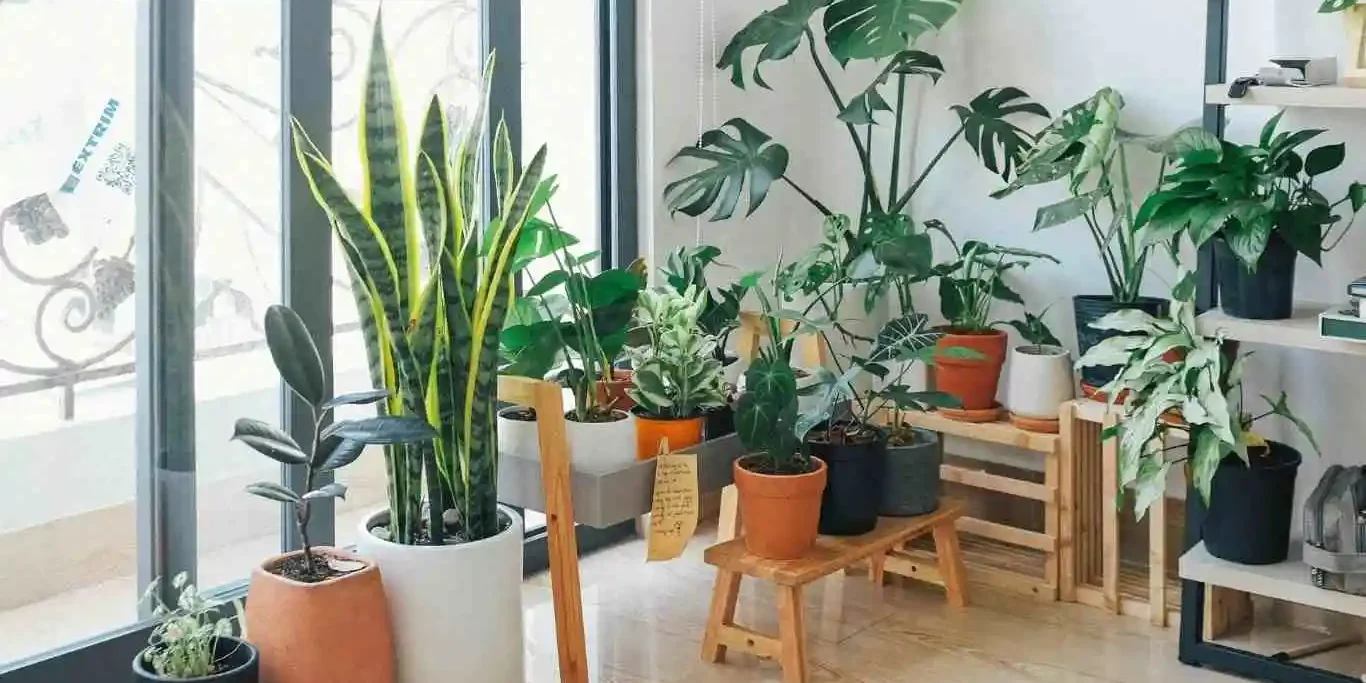Have you ever enjoyed going into a room full of green plants? If so, you will find this article useful. Houseplants can turn even the smallest room into a calm and welcoming place. But many beginners struggle to select the right plants and keep them alive for a few weeks. Overwatering, pests, or just picking plants that require more care than we can provide are all common issues.
The good news is that you can succeed without having a “green thumb”. If you start with the most popular houseplants, you can have hardy, lovely greenery that grows indoors with little effort. These plants make the room look nicer, improve air quality, boost mood, and reduce stress. In this guide, we’ll discuss some common and most popular indoor plants, how to identify and care for them, and tips for handling common houseplant pests. This article will boost your confidence and enjoy a home filled with flourishing greenery, whether you’re a first-time plant parent or hoping to expand your collection.
Why Choose Common Indoor Houseplants?
Choose some common indoor houseplants at the start because these plants are:
- Low-maintenance: Perfect for people who don’t want complicated care routines and have busy schedules.
- Widely available: These plants are available for purchase online, at local nurseries or even at supermarkets.
- Beginner-friendly: If you forget to water them once or twice, then it’s not a problem.
- Proven resilient: Millions of people who like plants have already tried it and liked it.
You can enjoy the indoor greenery’s beauty without unnecessary stress by choosing the most popular and common houseplants.
The Most Common Houseplants Every Home Should Have
Let’s explore some of the easiest and most loved houseplants you can start with.
- Nickname: Mother-in-Law’s Tongue.
- Known for: Upright sword-like leaves.
- Why it’s common: Exceptionally hardy, survives low light, has the ability to purify the air, and is simple to maintain as a houseplant.
- Care: Water should be supplied every two to three weeks.
Spider Plant (Chlorophytum comosum)
- Nickname: Airplane Plant or Ribbon Plant.
- Known for: Arching leaves. The leaves are green and white striped.
- Why it’s common: It grows quickly and yields “baby plants” that are simple to multiply.
- Care: It can stay alive with bright, indirect light and moderate watering.
- Nickname: Closet Plant.
- Known for: Glossy green leaves with pretty white blooms.
- Why it’s common: Both pretty and air-purifying.
- Care: Keep the soil moist to grow well, but avoid being too wet. Ideal for bright to medium light.
- Nickname: Medicine Plant or Plant of Immortality.
- Known for: Leaves of this plant contain healing gel.
- Why it’s common: Both decorative and valuable plants.
- Care: The plant loves sunlight, so keep it near a sunny window. Water only when the soil is dry.
- Nickname: Devil’s Ivy.
- Known for: Heart-shaped trailing leaves.
- Why it’s common: Fast-growing, adapts to various conditions, and looks stunning in hanging baskets.
- Care: It can stay alive in indirect light that is low to bright. Water the soil when it feels dry.
ZZ Plant (Zamioculcas zamiifolia)
- Nickname: Zanzibar Gem.
- Known for: Glossy, upright leaves.
- Why it’s common: Practically indestructible—can survive weeks of neglect.
- Care: Water occasionally and provide it low to moderate light.
Common Houseplant Identification Tips
Sometimes it’s tricky to know exactly what plant you’ve got. To help you identify the most common houseplants, here are some quick tips:
- Snake Plant: Tall, Green and yellow-edged leaves (look like a sword).
- Spider Plant: Long and arching leaves. There is a white stripe in the middle of the leaves, and the edges are green.
- Peace Lily: Broad green leaves. It contains white spathes that look like a flower.
- Pothos: Heart-shaped leaves that are variegated in neon, white, or gold.
- ZZ Plant: Thick, waxy leaves that shine.
- Aloe Vera: Thick, spiky leaves have something that looks like gel in them.
If you’re unsure, try using a plant identification app or ask in online plant communities.
How to Care for Common Indoor Houseplants
Plant maintenance doesn’t have to be difficult. Here’s a quick summary:
Watering Basics
- Most common houseplants like less water, not more. So, avoid overwatering because it is the top cause of plant death.
- Water must be added when the soil’s top inch feels dry. You can check it with your finger.
- Root rot can be avoided by using pots with drainage holes.
Lighting Needs
- Keep plants in a spot where they can get bright, indirect light.
- While south-facing windows are fantastic, harsh sunlight can be lessened with sheer curtains.
- Plants that don’t need a lot of light, like ZZ and snake plants, can do well in areas with little light.
Soil and Fertilizer
- Use well-draining potting soil for best results.
- Use an optimum dose of fertilizer during the spring and summer growing seasons. A balanced, water-soluble fertilizer is sufficient.
Cleaning and Maintenance
- Clean leaves with a moist cloth. This will help the plant breathe better and be healthier overall.
- Remove any yellow, dead, or dried leaves to encourage the growth of new plants.
Dealing with Common Houseplant Pests
Pests can be drawn to even the healthiest plants. The most prevalent pests of houseplants and their solutions are as follows:
- Aphids: Tiny sap-sucking black or green insects. Spray neem oil/soap water to control them.
- Spider Mites: Check under leaves for webbing. Wipe with neem oil solution.
- Mealybugs: Cotton-like clumps on stems. Spray soap water/neem oil to control them.
- Fungus Gnats: Tiny, black flies that hover over soil. Let the soil dry up between waterings to keep them away.
Prevention tip: Make sure new plants are pest-free by inspecting them before bringing them inside and isolating them for a few days.
Benefits of Keeping Common Houseplants
What makes common houseplants so important? They are more than just attractive.
- Air purification: According to NASA research, some houseplants can filter pollutants.
- Stress relief: Research shows that caring for plants improves mood and lowers anxiety.
- Boost creativity: A green environment improves concentration and productivity.
- Home décor: Immediately gives your room a livelier, cozier appearance.
Practical Tips for Beginners
- Start small by selecting two to three plants and getting to know their requirements.
- Plants with similar maintenance requirements should be grouped, which is a good idea.
- Keep a simple watering schedule and record it on the calendar app on your phone.
- Don’t worry about errors; plants are hardy and recover quickly.
Conclusion
One of the simplest ways to create a serene, lovely, and healthful atmosphere in your home is to add common houseplants. These indoor companions are forgiving, reasonably priced, and brimming with advantages, ranging from the low-maintenance Snake Plant to the perennially popular Peace Lily.
Remember: Light matters, pests can be controlled with simple solutions, and less water is frequently more. You will better understand your plants’ demands the more time you spend monitoring them.
If you’re ready to take the first step toward a greener home, start with a few of these most common houseplants and see how they brighten your space and your mood. Want more tips? Develop your confidence as a plant parent by reading through our other plant care guides.
Frequently Asked Questions (FAQs): Common Houseplants
What is the most common indoor plant?
The Snake Plant (Sansevieria trifasciata) is the most common and popular indoor plant. It is also known as Mother-in-Law’s Tongue. It is perfect for beginners because of its hardiness, low-maintenance, and thrives in low light. Spider Plant, Pothos, Peace Lily, Aloe Vera, and ZZ Plant are other well-known common plants.
How do I identify my houseplant?
You can identify a houseplant by observing key features like leaf shape, color patterns, size, and growth habit. You can also look at online plant communities, use plant identification apps, or compare your plant to a popular houseplant identification guide to see if the traits match.
How to take care of common houseplants?
The basics of caring for common houseplants are:
- Watering: Water must be added if you see that the top inch of soil is dry.
- Light: Provide bright, indirect light; low-light plants like ZZ and Snake can tolerate dimmer areas.
- Soil & Fertilizer: During the growing season, use potting soil that drains well and a balanced fertilizer that dissolves in water.
- Maintenance: Clean the leaves with a moist cloth, trim yellow/dry/dead leaves, and monitor for pests.
What are indoor plants’ names?
Some of the most common indoor plant names include: Snake Plant, Spider Plant, Peace Lily, Aloe Vera, Pothos, ZZ Plant, Fiddle Leaf Fig, Rubber Plant, and Boston Fern. People like these plants because they look nice, are easy to care for, and clean the air.
If you want to enjoy fresh harvests year-round, check out our detailed guide on Indoor Fruit Trees: How to Grow Fresh Harvests Inside Your Home









